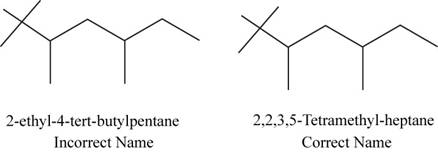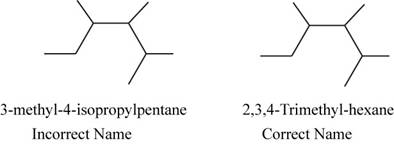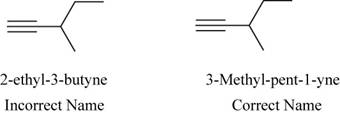
Concept explainers
(a)
Interpretation: The following incorrectly named compounds are to be drawn and named correctly.
Concept introduction: Organic compounds contain carbon and hydrogen atoms with their respective
To determine: The correct name of the given compound and its structure is to be drawn.
(a)
Answer to Problem 111AE
Answer
The correct name of the compound is
Explanation of Solution
Explanation
The correct name of the compound is
The structure of

Figure 1
The root name hexane signifies the presence of six carbon atoms.
(b)
Interpretation: The following incorrectly named compounds are to be drawn and named correctly.
Concept introduction: Organic compounds contain carbon and hydrogen atoms with their respective functional groups. When they are named the root term, suffix and prefix are to be remembered. They are named according to the International Union of Pure and Applied Chemistry
To determine: The correct name of the given compound and its structure is to be drawn.
(b)
Answer to Problem 111AE
Answer
The correct name of the compound is
Explanation of Solution
Explanation
The correct name of the compound is
The structure of

Figure 2
The root name is pentane which signifies the presence of five carbon atoms in a chain,
(c)
Interpretation: The following incorrectly named compounds are to be drawn and named correctly.
Concept introduction: Organic compounds contain carbon and hydrogen atoms with their respective functional groups. When they are named the root term, suffix and prefix are to be remembered. They are named according to the International Union of Pure and Applied Chemistry
To determine: The correct name of the given compound and its structure is to be drawn.
(c)
Answer to Problem 111AE
Answer
The correct name of the compound is
Explanation of Solution
Explanation
The correct name of the compound is
The structure of 3-methyl 4-isopropylpentane with its correct name is,

Figure 3
The root name pentane signifies the presence of five carbon atoms in a chain and
(d)
Interpretation: The following incorrectly named compounds are to be drawn and named correctly.
Concept introduction: Organic compounds contain carbon and hydrogen atoms with their respective functional groups. When they are named the root term, suffix and prefix are to be remembered. They are named according to the International Union of Pure and Applied Chemistry
To determine: The correct name of the given compound and its structure is to be drawn.
(d)
Answer to Problem 111AE
Answer
The correct name of the compound is
Explanation of Solution
Explanation
The correct name of the compound is
The structure of

Figure 4
The root name butyne signifies the presence of four carbon atoms with a triple bond in a chain and
Want to see more full solutions like this?
Chapter 21 Solutions
EBK CHEMISTRY: AN ATOMS FIRST APPROACH
- Identify the mechanism through which the following reaction will proceed and draw the major product. Part 1 of 2 Br KOH EtOH Through which mechanism will the reaction proceed? Select the single best answer. E1 E2 neither Part: 1/2 Part 2 of 2 Draw the major product formed as a result of the reaction. Click and drag to start drawing a structure. Xarrow_forwardWhat is single-point calibration? Provide an example.arrow_forwardDraw the major product formed via an E1 pathway.arrow_forward
- Part 9 of 9 Consider the products for the reaction. Identify the major and minor products. HO Cl The E stereoisomer is the major product and the Z stereoisomer is the minor product ▼ S major product minor productarrow_forwardConsider the reactants below. Answer the following questions about the reaction mechanism and products. HO Clarrow_forwardjulietteyep@gmail.com X YSCU Grades for Juliette L Turner: Orc X 199 A ALEKS - Juliette Turner - Modul X A ALEKS - Juliette Turner - Modul x G butane newman projection - Gox + www-awa.aleks.com/alekscgi/x/Isl.exe/10_u-IgNslkr7j8P3jH-IBxzaplnN4HsoQggFsejpgqKoyrQrB2dKVAN-BcZvcye0LYa6eXZ8d4vVr8Nc1GZqko5mtw-d1MkNcNzzwZsLf2Tu9_V817y?10Bw7QYjlb il Scribbr citation APA SCU email Student Portal | Main Ryker-Learning WCU-PHARM D MySCU YSCU Canvas- SCU Module 4: Homework (Ch 9-10) Question 28 of 30 (1 point) | Question Attempt: 1 of Unlimited H₂SO heat OH The mechanism of this reaction involves two carbocation intermediates, A and B. Part 1 of 2 KHSO 4 rearrangement A heat B H₂O 2 OH Draw the structure of A. Check Search #t m Save For Later Juliet Submit Assignm 2025 McGraw Hill LLC. All Rights Reserved. Terms of Use | Privacy Center | Accessarrow_forward
- The electrons flow from the electron-rich atoms of the nucleophile to the electrons poor atoms of the alkyl halide. Identify the electron rich in the nucleophile. Enter the element symbol only, do not include any changes.arrow_forwardHello, I am doing a court case analysis in my Analytical Chemistry course. The case is about a dog napping and my role is prosecution of the defendant. I am tasked in the Area of Expertise in Neutron Activation and Isotopic Analysis. Attached is the following case study reading of my area of expertise! The landscaping stone was not particularly distinctive in its decoration but matched both the color and pattern of the Fluential’s landscaping stone as well as the stone in the back of the recovered vehicle. Further analysis of the stone was done using a technique called instrumental neutron activation analysis. (Proceed to Neutron Activation data) Photo Notes: Landscaping stone recovered in vehicle. Stone at Fluential’s home is similar inappearance. Finally, the white paint on the brick was analyzed using stable isotope analysis. The brick recovered at the scene had smeared white paint on it. A couple of pieces of brick in the back of the car had white paint on them. They…arrow_forwardCite the stability criteria of an enamine..arrow_forward
 World of Chemistry, 3rd editionChemistryISBN:9781133109655Author:Steven S. Zumdahl, Susan L. Zumdahl, Donald J. DeCostePublisher:Brooks / Cole / Cengage Learning
World of Chemistry, 3rd editionChemistryISBN:9781133109655Author:Steven S. Zumdahl, Susan L. Zumdahl, Donald J. DeCostePublisher:Brooks / Cole / Cengage Learning
 Chemistry for Today: General, Organic, and Bioche...ChemistryISBN:9781305960060Author:Spencer L. Seager, Michael R. Slabaugh, Maren S. HansenPublisher:Cengage Learning
Chemistry for Today: General, Organic, and Bioche...ChemistryISBN:9781305960060Author:Spencer L. Seager, Michael R. Slabaugh, Maren S. HansenPublisher:Cengage Learning Chemistry: An Atoms First ApproachChemistryISBN:9781305079243Author:Steven S. Zumdahl, Susan A. ZumdahlPublisher:Cengage Learning
Chemistry: An Atoms First ApproachChemistryISBN:9781305079243Author:Steven S. Zumdahl, Susan A. ZumdahlPublisher:Cengage Learning Introductory Chemistry: An Active Learning Approa...ChemistryISBN:9781305079250Author:Mark S. Cracolice, Ed PetersPublisher:Cengage Learning
Introductory Chemistry: An Active Learning Approa...ChemistryISBN:9781305079250Author:Mark S. Cracolice, Ed PetersPublisher:Cengage Learning World of ChemistryChemistryISBN:9780618562763Author:Steven S. ZumdahlPublisher:Houghton Mifflin College Div
World of ChemistryChemistryISBN:9780618562763Author:Steven S. ZumdahlPublisher:Houghton Mifflin College Div





